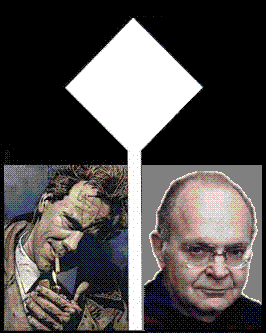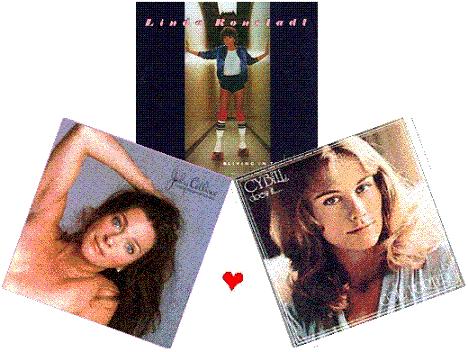Month: February 2005
-
Spider

Spider is THE journalist of the future. He smokes, he does drugs, and he
kicks ass. The drugs are going to eventually kill him but not before
he gets his way. And his way is the demise of the failed American dream.
Although full of hate, he cares about his city. All he wants to
bring the world is truth. Spider Jerusalem, conscience of the City.
Frightening thought, but he's the only one we've got."-- What Gritty No Nonsense Comic Book Character are You? brought to you by Quizilla
The following references to the Fritz Leiber story "Damnation Morning" seem relevant:
-
Relativity Blues
Today, February 20, is the 19th anniversary of my note The Relativity Problem in Finite Geometry. Here is some related material.
In 1931, the Christian writer Charles Williams grappled with the theology of time, space, free will, and the many-worlds interpretation of quantum mechanics (anticipating by many years the discussion of this topic by physicists beginning in the 1950's).
(Some pure mathematics -- untainted by physics or theology --
that is nevertheless related, if only by poetic analogy, to Williams's 1931
novel, Many Dimensions, is discussed in the above-mentioned note and in a generalization, Solomon's Cube.)On the back cover of Williams's 1931 novel, the current publisher, William B. Eerdmans Publishing Company of Grand Rapids, Michigan, makes the following statement:
"Replete with rich religious imagery, Many Dimensions explores the
relation between predestination and free will as it depicts different
human responses to redemptive transcendence."One possible response to such statements was recently provided in some detail by a Princeton philosophy professor. See On Bullshit, by Harry G. Frankfurt, Princeton University Press, 2005.
A more thoughtful response would take into account the following:
1. The arguments presented in favor of philosopher John Calvin, who discussed predestination, in The Death of Adam: Essays on Modern Thought, by Marilynne Robinson
2. The physics underlying Einstein's remarks on free will, God, and dice
3. The physics underlying Rebecca Goldstein's novel Properties of Light and Paul Preuss's novels Secret Passages and Broken Symmetries4. The physics underlying the recent so-called "free will theorem" of John Conway and Simon
Kochen of Princeton University5. The recent novel Gilead, by Marilynne Robinson,
which deals not with philosophy, but with lives influenced by
philosophy -- indirectly, by the philosophy of the aforementioned John
Calvin.From a review of Gilead by Jane Vandenburgh:
"In The Death of Adam, Robinson shows Jean Cauvin to be the foremost
prophet of humanism whose Protestant teachings against the hierarchies
of the Roman church set in motion the intellectual movements that
promoted widespread literacy among the middle and lower classes, led to
both the American and French revolutions, and not only freed African
slaves in the United States but brought about suffrage for women. It's
odd then that through our culture's reverse historicism, the term 'Calvinism' has come to mean 'moralistic repression.'"For more on what the Calvinist publishing firm Eerdmans calls "redemptive transcendence," see various July 2003 Log24.net entries.
If these entries include a fair amount of what Princeton philosophers
call bullshit, let the Princeton philosophers meditate on the summary
of Harvard philosophy quoted here on November 5 of last year, as well as the remarks of November 5, 2003, and those of November 5, 2002.From Many Dimensions (Eerdmans paperback, 1963, page 53):
"Lord Arglay had a suspicion that the Stone would be purely
logical. Yes, he thought, but what, in that sense, were the rules
of its pure logic?"Modal Theology
"We symbolize logical necessity
with the box(  )
)
and logical possibility
with the diamond( " ).
).
-- Keith Allen Korcz,
(Log24.net, 1/25/05)
And what do we
symbolize by
 ?
?"The possibilia that exist,
and out of which
the Universe arose,
are located in
a necessary being...."
-- Michael Sudduth,
Notes on
God, Chance, and Necessity
by Keith Ward,
Regius Professor of Divinity
at Christ Church College, Oxford
(the home of Lewis Carroll) -
Highway
From previous Log24.net entries:
"There is no highway in the sky."
-- Quotation attributed to
Albert Einstein.
(See Gotthard Günther's website
"Achilles and the Tortoise, Part 2".)"Don't give up until you
Drink from the silver cup
And ride that highway in the sky."
-- America, 1974Stephen Yablo, draft of
"A Paradox of Existence,"
Nov. 8, 1998, section heading:"III. Quine's way or the highway"
From that section:
"Burgess & Rosen begin their book A Subject with No Object with a relevant fable:
Finally,
after years of waiting, it is your turn to put a question to the Oracle
of Philosophy...you humbly approach and ask the question that has been
consuming you for as long as you can remember: 'Tell me, O Oracle, what
there is. What sorts of things exist?' To this the Oracle responds:
'What? You want the whole list? ...I will tell you this: everything
there is is concrete; nothing there is is abstract....'Suppose we continue the fable a little. Impressed with what the Oracle
has told you, you return to civilization to spread the concrete gospel.
Your first stop is at [your school here]...."
The Concrete Gospel
of Donald E. Knuth:In Hoc Signo
(from yesterday),
continued --
This holy icon
appeared at
N37°25.638'
W122°09.574'
on August 22, 2003,
at the Stanford campus.See also
Cognitive Blending
and the Two Cultures. -
In Hoc Signo

Sources:Hellblazer: Highwater,
from a graphic-novel
series that is the source
of Keanu Reeves's latest
spiritual adventure --Another source...
The home page of Donald E. Knuth."When there's nothing to believe in
Still you're coming back,
you're running back
You're coming back for moreSo put me on a highway...."
-- The Eagles, 1975 -
Modal Theology
"We symbolize logical necessity
with the box(  )
)
and logical possibility
with the diamond( " ).
).
-- Keith Allen Korcz,
(Log24.net, 1/25/05) And what do wesymbolize by
On the Lapis ?
?
Philosophorum,
the Philosophers' Stone -"'What is this Stone?' Chloe asked....
'...It is told that,
when the Merciful One
made the worlds, first of all He created
that
Stone and gave it to the Divine One
whom the Jews call Shekinah,
and
as she gazed upon it
the universes arose and had being.'"
- Many Dimensions,
by Charles Williams, 1931
(Eerdmans
paperback,
April 1979, pp.
43-44)"The lapis was thought of as a unity
and therefore often stands
forthe prima materia in general."
- Aion, by C.
G. Jung, 1951(Princeton paperback,
1979, p. 236)
"Its discoverer was of the opinion that
he had produced the
equivalent of
the primordial protomatter
which exploded into the
Universe."
- The Stars My Destination,
by Alfred
Bester, 1956
(Vintage hardcover,
July 1996, p. 216)
"The possibilia that exist,and out of which
the Universe arose,
are located in
a necessary being...."-- Michael Sudduth,
Notes on
God, Chance, and Necessity
by Keith Ward,
Regius Professor of Divinity
at Christ Church College, Oxford
(the home of Lewis Carroll)See also
The Diamond Archetype.For more on modal theology, see
Kurt Gödel's Ontological Argument
and
The Ontological Argument
from Anselm to Gödel. -
Answer
"Are you now, or have you ever been?"
-- Question posed to Philip Johnson,
entry of Feb. 12"In the case of the Cartesian
question, the answer is affirmative, and metaphysics has produced, in
the four hundred years since, nothing much better than this. It is
not only interesting but supremely practical. What could be more
useful than having the means of convincing oneself that one exists
whenever the question should arise?"-- Rebecca Goldstein,
Properties of Light"... a nightshirted boy trying desperately to awake from the iridescent
dizziness of dream life. Its ultimate vision was the incandescence of a
book or a box grown completely transparent and hollow. This is, I
believe, it: not the crude anguish of physical death but the
incomparable pangs of the mysterious mental maneuver needed to pass
from one state of being to another."-- Vladimir Nabokov,
Transparent Things"Le terme
que l'on traduit par dédicace est en japonais ekô, littéralement 'se tourner vers'. Il est composé de deux idéogrammes, e qui signifie 'tourner le dos, se tourner, revenir en arrière' et kô, 'faire face, s'adresser à'."
Rebecca
GoldsteinFor more on Goldstein, see
The New York Times,
Feb. 14, 2005, and
Eight is a Gate,
Dec. 19, 2002.






Recent Comments